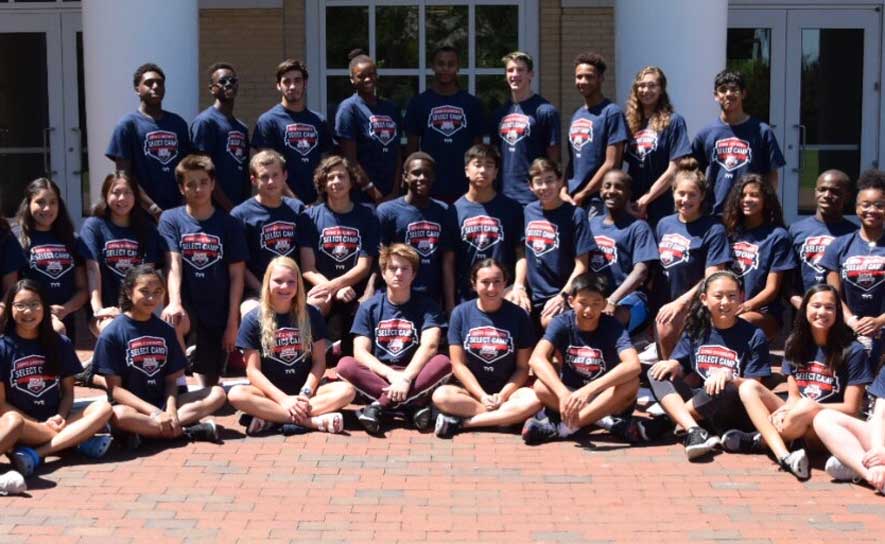USA Swimming News
Diversity Select Camps Prep Under-Represented Swimmers for Big Things in the Pool

by By Paul D. Bowker//Red Line Editorial
The next wave of American Olympic swimmers could come from unexpected places.
USA Swimming’s Diversity Select Camps program is prepping swimmers from under-represented U.S. populations to not only be the next big things in the pool but also training them to be leaders in their communities.
It could be a wild ride with a huge payoff.
In June alone, 96 swimmers trained for a weekend in Eastern and Southern Diversity Select Zone Camps at the University of Maryland and University of South Carolina. Another 48 swimmers participated in the invitation-only 13th annual National Diversity Select Camp in May in Colorado Springs, Colorado.
The zone camps, which are rotated among USA Swimming’s Western, Central, Southern and Eastern zones every other year, have drawn African-American, Hispanic-Latino, Asian-Pacific Islander and Native American swimmers who are 13 to 16 years old. Each camp lasts a full three-day weekend and is limited to 48 swimmers who must qualify for invitations.
“This creates an environment where athletes can come and see other athletes that look like them,” said Juan Caraveo, who serves as diversity and inclusion consultant for USA Swimming. “‘OK, these are now my teammates. Together, we’ll grow and go back to our communities and be leaders in our community for athletes of color, athletes from other under-represented populations, to be role models for those younger athletes. … This sport is for us.’”
The movement is picking up steam with its unified message: “We Are One.”
“Coaches and teams have always done a great job of developing talent here in the U.S. I believe that’s why we’re the No. 1 swimming country in the world and have been for decades,” Caraveo said. “I think now we’re multiplying the impact of these camps because more athletes are going back and encouraging their friends, their families, to swim and to participate in the sport.”
One of the program’s graduates is already a well-known name. Simone Manuel, who participated in the 2011 National Diversity Select Camp, won four medals at the Rio Olympics, including two gold medals.
Jack LeVant, who attended the 2015 National Diversity Select Camp, and Daniel Roy, 2016, are also on the national team. Both are swimmers at Stanford University. Diversity Camp 2016 grads Alexandra Crisera and Isabel Gormley, and 2017 grad Dare Rose are on the USA Swimming Junior National Team.
“We look at it as their first step onto Team USA,” Caraveo said of the zone camps. “We focus and spend a lot of time on the team concept. You are now representing not only yourself, your family, your team, your region, but you’re now also a part of Team USA, so you’re representing your country.”
For some participants, one year it’s the zone camp and the next year it’s the national camp. After that, the goal is to make the junior or senior national team.
The camps go far beyond the swimming pool. Participants are involved in a number of motivational and educational seminars that include topics of communication, nutrition, sports psychology, and strength and conditioning. Camps also include social activities and special projects, such as cleaning a beach or helping out at a shelter. Two sessions a day are in the water.
“It’s a pretty intense three days,” said Caraveo, who was a former high school swim coach and head club coach at Pearland Aquatics in Texas.
The camps aren’t looking to take over the athletes’ training, Caraveo said, but rather to help supplement it.
“We definitely look to support the work that the home coaches and the athletes are doing together,” Caraveo said. “We don’t look to correct strokes. We look to support and reinforce the work they have done that got them to camp.”
Caraveo, who came on board in 2015, has already seen a marked increase in the skill levels of swimmers just over the 10 zone camps he has attended.
“The magic is within them,” he said. “Our coaching staff, our challenge to them is to help draw it out. It is one of the coolest things when you see a group of 48 individuals arrive and they leave as a team in that short a period of time.”
Afterward, the relationships have gotten so close that camp participants and coaches stay in touch through social media. New friendships are established.
“That’s one of the most beautiful things to me about the camp,” Caraveo said.
Caraveo is hopeful that the zone camps grow from two to four per year. The way the rotation currently is, USA Swimming’s Western and Central zones would host the zone camps in 2020.
Paul D. Bowker has been writing about Olympic sports since 1996, when he was an assistant bureau chief in Atlanta. He is a freelance contributor to USA Swimming on behalf of Red Line Editorial, Inc. Follow him on Twitter: @bowkerpaul.
